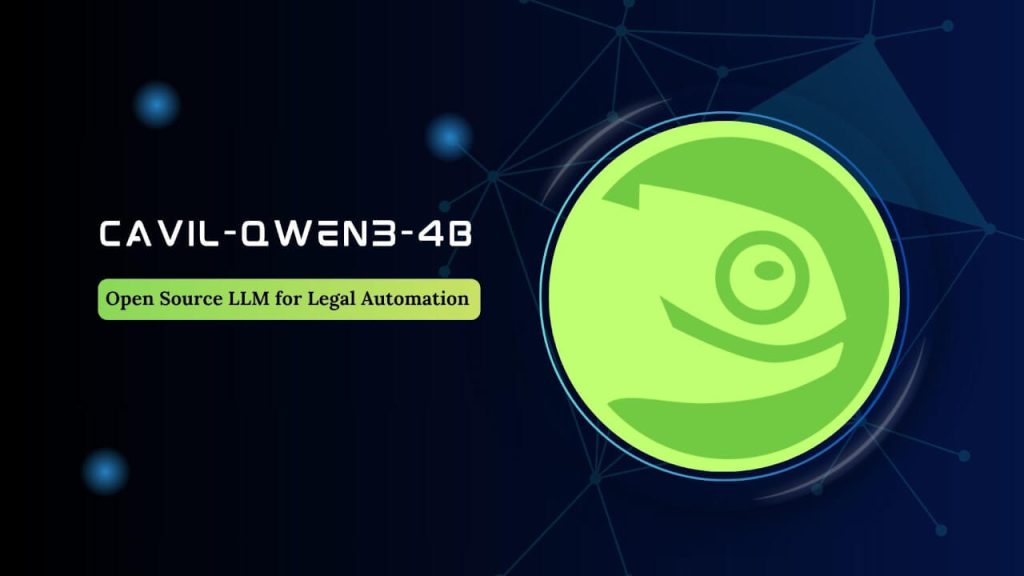Understanding software licenses can be a major headache for open-source developers and communities. Ensuring your project adheres to various legal requirements protects it from future risks. Imagine a tool that simplifies this, making enterprise-grade legal checks accessible to everyone. SUSE has now released just such a tool: Cavil-Qwen3-4B. This innovative open source large language model brings powerful automation to legal compliance, designed specifically to fuel community collaboration.
What is Cavil-Qwen3-4B?
Cavil-Qwen3-4B is an open-source Large Language Model (LLM) designed by SUSE to automate legal compliance within the open-source community.
This fine-tuned model, built upon the Qwen3-4B base, utilises a LoRA adapter to efficiently detect legal information like license declarations in code.
Its 4B parameter size balances performance with deployability, making it compatible with consumer-grade GPUs.
At its core, Cavil-Qwen3-4B is a synergistic blend of two powerful components:
CavilQwen3-4B
1. Cavil: The Foundation for Legal Review
Cavil is already the trusted legal review and Software Bill of Materials (SBOM) system used by SUSE and openSUSE.
It plays an important role in developing major Linux distributions like openSUSE Tumbleweed, openSUSE Leap, and SUSE Linux Enterprise.
Cavil offers robust features including:
Source code legal review for various formats, from RPMs to Docker images.A high-performance scanner that can recursively decompress almost any archive.A massive collection of 28,000 curated patterns for 2,000 license combinations, with 500 distinct SPDX expressions. This data is expertly curated by SUSE lawyers.Support for SBOM with SPDX 2.2 reports.More importantly, it includes human reviews by lawyers who assess legal risks for every pattern match.It’s mainly developed using Perl.
2. Qwen3-4B: The Intelligent Language Model
Qwen3-4B is a cutting-edge large language model (LLM) from the Qwen series. It boasts 4.0 billion parameters and is designed for powerful performance.
Key capabilities include:
A unique ability to seamlessly switch between a “thinking mode” for complex logical reasoning (like maths or coding) and a “non-thinking mode” for general conversations.Significant enhancements in reasoning, outperforming previous models in areas like mathematics and code generation.Support for over 100 languages and dialects, with strong multilingual instruction following.It operates under the OSI-approved Apache 2.0 license, which allows commercial use and redistribution.
The Magic of Integration: Cavil-Qwen3-4B
SUSE has taken the powerful Qwen3-4B base model and fine-tuned it using a LoRA adapter (Low-Rank Adaptation).
This adaptation specifically trains the model to detect legally relevant text, such as license declarations, within code and documentation.
It draws directly from the expertise embedded in openSUSE’s compliance tool, Cavil.
The choice of a 4B parameter size is strategic. It strikes an excellent balance, providing strong language understanding while remaining compatible with consumer-grade GPUs, making it highly deployable for many developers.
How Does Cavil-Qwen3-4B LLM Benefit the Open Source Community and Developers?
The release of Cavil-Qwen3-4B brings several substantial advantages:
1. Unprecedented Accessibility
Its primary benefit is to make legal compliance automation far more accessible to developers across the open-source ecosystem.
This means more projects, regardless of size, can easily integrate robust legal review processes.
2. Enterprise-Grade Compliance for All
As Sebastian Riedel, a project contributor, highlighted, this model “brings enterprise-grade legal classification to the broader developer community”.
It acts as a practical tool for any project that wants to stay ahead of compliance risks without heavyweight infrastructure.
This will be quite useful for smaller teams or individual contributors who lack the resources for costly, complex compliance systems.
3. High Accuracy and Efficiency
The model was trained on a substantial 150,000-sample dataset using the Alpaca instruction format.
It has demonstrated high accuracy in identifying license headers and similar legal text when evaluated against other open models.
Plus, its design supports efficient use, even on smaller devices, with quantization options.
4. Transparency and Collaborative Growth
Being open source means the dataset and validation tools used to create Cavil-Qwen3-4B are also openly available via Hugging Face.
This transparency allows researchers and developers to reproduce the work, understand its methodology, and contribute to its evolution.
5. Flexible Licensing
Both the base Qwen3-4B model and the Cavil LoRA adapter are licensed under the Apache-2.0 license.
This permissive, OSI-approved license allows for commercial use and redistribution, offering great flexibility for a wide range of projects.
Try Cavil-Qwen3-4B LLM
SUSE’s Cavil-Qwen3-4B LLM simplifies the legal compliance in the open source community. It leverages AI to handle tedious checks, freeing up developers to focus on innovation.
This open-source release makes high-quality legal classification practical and affordable for everyone.
Are you interested to try it? Explore Cavil-Qwen3-4B on openSUSE’s Hugging Face today! Your contributions and insights are highly valued.

